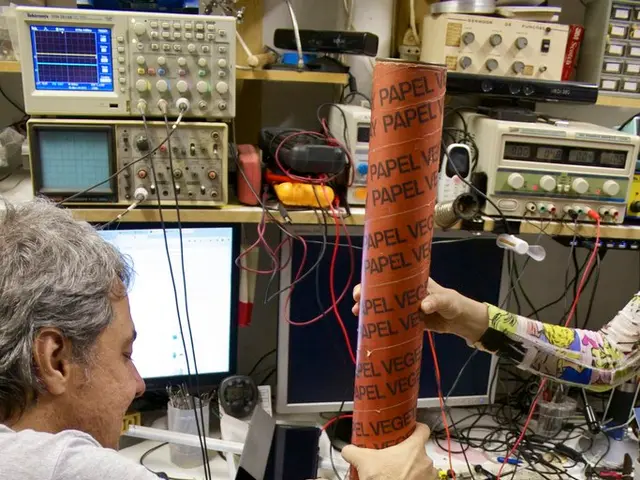Exploring the Kardashev Scale: A Roadmap for Humanity Towards Type-I Advanced Civilization Status
The pursuit of a Type-I civilization, as defined by Soviet physicist Nikolai Kardashev, is gaining momentum in the global scientific community. This ambitious goal, which would see humanity harnessing all of Earth's available energy, including renewable sources, is being approached through advancements in solar power, nuclear fusion, and artificial intelligence (AI).
Solar power, with its abundant and technically feasible potential, is considered the most promising energy source for achieving Type-I civilization energy consumption rates. Terrestrial solar power technologies are rapidly advancing, with improvements in photovoltaic materials, solar thermal systems, and storage solutions. Meanwhile, space-based solar power (SBSP) is an active area of research, with proposed systems involving large solar arrays in orbit that beam energy back to Earth via microwaves or lasers. This could provide continuous, weather-independent power and help bridge the gap towards total planetary energy control.
Controlled nuclear fusion stands out as a critical technology for achieving Type-I status. Fusion offers a clean, virtually limitless source of energy, and ongoing projects like ITER and other experimental reactors worldwide are progressing toward sustainable and continuous fusion power generation. Mastery of fusion would enable energy production on a scale and with an environmental footprint suitable for planetary-wide consumption and integration.
While the Kardashev scale itself primarily measures energy usage rather than AI development, artificial intelligence plays a pivotal role in optimizing energy production, distribution, and consumption systems. AI can enable smart grids, predictive maintenance, demand response, and planetary-scale energy efficiency improvements, which are necessary to handle the massive energy flows and complex infrastructures characteristic of a Type-I civilization. Advanced AI-driven management could also help mitigate environmental impacts and enhance global cooperation through optimized resource allocation and integration of diverse energy sources.
However, reaching Type-I status requires not only technological breakthroughs but also profound socio-political transformations, including global cooperation, sustainable practices, and ethical governance of powerful energy technologies. The scale of infrastructure needed is immense, requiring integration of diverse renewable sources, fusion power, and space-based solar systems, all coordinated through sophisticated AI energy management frameworks to stabilize the planetary environment and energy access.
As Carl Sagan and other scholars note, humanity is currently around 0.7 on the Kardashev scale, indicating significant progress but still far from full planetary energy control, which is estimated to be about a century away under optimistic trajectories. The rise of humanity as a Type-I civilization will require a focus on building the necessary energy infrastructure now, whether through fusion, solar, or other means. Technological advancements like machine learning and quantum computing have the potential to transform the energy industry, laying the groundwork for the potential rise of humanity as a Type-I civilization.
[1] Project ITER (n.d.). Retrieved from https://www.iter.org/ [3] Kardashev, N. S. (1964). Extraterrestrial civilizations of the first two types. Soviet Astronomy, 10(2), 50-54.
- On top of solar power advancements, projects like ITER and various experimental reactors worldwide are focusing on controlled nuclear fusion, aiming to generate sustainable and continuous fusion power.
- In the field of environmental science, AI can facilitate sustainable practices by enabling smart grids, predictive maintenance, and demand response, thereby optimizing energy consumption systems.
- The home-and-garden sector could benefit from advancements in energy technology, as efficiency improvements and the integration of renewable energy sources lower reliance on traditional fossil fuels.
- Financial institutions are increasingly eyeing investing opportunities in renewable energy projects, recognizing their long-term potential and the ethical implications of funding sustainable living initiatives.
- Lifestyle choices centered on sustainable living, such as reducing carbon footprint, will be essential for human society to reach Type-I status, given the impact of personal energy consumption on the environment.
- Real-estate development could play a crucial role in the transition to a Type-I civilization, as buildings are retrofitted to accommodate and integrate the latest renewable energy technologies and AI systems for improved energy efficiency.
- Data-and-cloud-computing firms can contribute to the pursuit of a Type-I civilization by harnessing AI to optimize the vast amounts of data generated by energy systems, which helps streamline operations, reduce waste, and increase energy output.
- Sports-betting platforms might seem unrelated, but they can provide an avenue for fundraising and research, with proceeds supporting projects aimed at fusion energy, sustainable living, and other elements crucial for the growth of a Type-I civilization.




